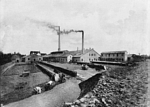 |
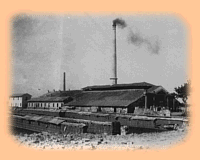 The complex, made up
of various buildings, highlights in the progression of events the industrial evolution in
Italy, tied both to the agricultural activity and to the European and even Oriental
cultural influence. We can plainly see this influence in the north-eastern façade of the
factory, decorated with a ceramic frieze currently undergoing restoration, representing a
Japanese dancer.
The complex, made up
of various buildings, highlights in the progression of events the industrial evolution in
Italy, tied both to the agricultural activity and to the European and even Oriental
cultural influence. We can plainly see this influence in the north-eastern façade of the
factory, decorated with a ceramic frieze currently undergoing restoration, representing a
Japanese dancer.
The original building of the “mezzà”, in Veneto dialect meaning mezzanine or study, has the characteristic look of a Veneto villa with front porch and adjacent columns and also two sun-dials, which at the beginning of the activity of the kiln, measured the rhythm of the work. In front of this building, Vincenzo Guerra ordered the brick factory to be built in over a pre-existing industrial manufacturer in 1840. Vincenzo Guerra was a noble Friulian gentleman from Cividale, born in Casier in 1791. Around this original structure new factories were born one by one adapted to both industrial and agricultural activity.
1840-1870 |
Vincenzo Guerra |
| 1870-1887 | Regina Guerra-Gregorj |
| 1887-1913 | Gregorio Gregorj |
| 1913-1924 | Giorgio Gregorj |
| 1924-1965 | Alfredo Gregorj |
After a production of mostly bricks, valued for their highly resistant quality and used also for the restoration of antique buildings, the factory was directed to expand in 1870, by the only daughter that Vincenzo Guerra had by his wife Elisabetta Paradisi, Regina. Regina had married Bartolomeo Gregorj, and was quickly left a widow. She was one of the first women entrepreneurs of the time, in a time in which the women in Italy did not yet have the right to vote, and was well-known and respected even outside of the region. So much was this true that in Milan, at the National Exhibition of 1881, Regina received a medal for her products and in Venice a group of glass workers dedicated a work of art made especially to her. In 1886 production of artistic objects in terracotta was started, using a special oven for the coloration and glazing.
 After a short time, Regina was joined
by her son Gregorio, who immediately after finishing his high school studies had to give
up going to university in favour of his younger brother Vincenzo, who then would graduate
an engineer, in order to become as he liked to call himself, a “humble furnace
worker”. A person with varied hobbies and interests, ranging from sociology and
literature to industrial pursuits, Gregorio knew instinctively how to give the kiln an
ultramodern aspect for those times. The complex was destroyed by a fire in 1887 and was
immediately rebuilt afterwards with a large financial outlay, to the point where Gregorio
had to sell his house, Villa Ca' Barbaro (now called Buri), built on the ruins of the
villa previously owned by their grandfather, and had to move to a more modest home in Via
St. Antonino.
After a short time, Regina was joined
by her son Gregorio, who immediately after finishing his high school studies had to give
up going to university in favour of his younger brother Vincenzo, who then would graduate
an engineer, in order to become as he liked to call himself, a “humble furnace
worker”. A person with varied hobbies and interests, ranging from sociology and
literature to industrial pursuits, Gregorio knew instinctively how to give the kiln an
ultramodern aspect for those times. The complex was destroyed by a fire in 1887 and was
immediately rebuilt afterwards with a large financial outlay, to the point where Gregorio
had to sell his house, Villa Ca' Barbaro (now called Buri), built on the ruins of the
villa previously owned by their grandfather, and had to move to a more modest home in Via
St. Antonino.
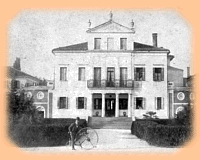 The discontinuous
fire oven was substituted by a Hoffmann oven which allowed for the continuous production
of goods from spring until autumn. Gregorio introduced other machinery to increase the
production and the quality and variety of the products. He also had the façade of the
kiln made more beautiful with the addition of neo-classical style columns, in a form
visible to this day.
The discontinuous
fire oven was substituted by a Hoffmann oven which allowed for the continuous production
of goods from spring until autumn. Gregorio introduced other machinery to increase the
production and the quality and variety of the products. He also had the façade of the
kiln made more beautiful with the addition of neo-classical style columns, in a form
visible to this day.
At the end of the 1800's about one hundred workers worked at the kiln, "all insured" and living in the "worker's housing" built especially with a piece of rental agricultural land available.
 Gregorio added to the brick production
unit, already going at a rate of about 3 million pieces per year, that of ceramics, for
which he had a continuous fire oven built which represented an innovation for the times
(there were only 3 or 4 at that time in Italy). In 1894, the ovens began producing a
special quality of pressed bricks that met the architectonic needs of that time which
required specially formed “plate” bricks with polished edges. Gregorio also
created an experimental technique for the special coloration of bricks called “high
heat fired” for which he obtained the patent in 1895. A special workmanship “in
graffito” was created in order to simulate the texture of cloth on the decorative
tiles.
Gregorio added to the brick production
unit, already going at a rate of about 3 million pieces per year, that of ceramics, for
which he had a continuous fire oven built which represented an innovation for the times
(there were only 3 or 4 at that time in Italy). In 1894, the ovens began producing a
special quality of pressed bricks that met the architectonic needs of that time which
required specially formed “plate” bricks with polished edges. Gregorio also
created an experimental technique for the special coloration of bricks called “high
heat fired” for which he obtained the patent in 1895. A special workmanship “in
graffito” was created in order to simulate the texture of cloth on the decorative
tiles.
Under Gregorio's management, the production of artistic ceramics, already begun in the times of Regina, was developed further, to the point where he collected many national and European awards.
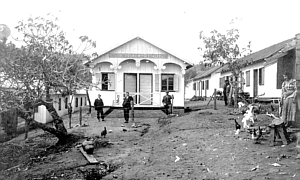 Gregorio was actively
involved in the social problems of the Treviso region, in particular those of the farmers
and the problems of emigration. He was a member of the Progressive party and offered a
valid contribution to the administration of the city. Gregorio was a promoter within his
own company of the Society for the Mutual Aid among the workers.
Gregorio was actively
involved in the social problems of the Treviso region, in particular those of the farmers
and the problems of emigration. He was a member of the Progressive party and offered a
valid contribution to the administration of the city. Gregorio was a promoter within his
own company of the Society for the Mutual Aid among the workers.
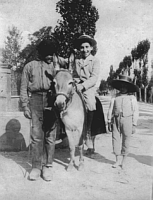 Gregorio Gregorj left many
writings regarding
social problems. He collaborated with the journal “L'Adriatico” and founded in
1898 the “Bulletin of the Ceramics Industry” (“Bollettino dell'Industria
Ceramica”). There are, still unedited, his correspondence, a collection of poetry, an
incomplete dictionary of the Treviso dialect and a diary of the first world war. Singular
among the unedited writings is the “Song of Spring” (“Canzone di
Primavera”) written in Paris in 1900. He was nominated Cavaliere della Corona for his
industrial achievements. He entertained close ties with people dedicated to culture such
as Augusto Serena, the painter August Cézanne and the abbot Luigi Bailo, founder of the
civil museum of Treviso as well as other people from foreign cultures. He was in contact
with entrepreneurs in this sector from France, England, Hungary, and Japan.
Gregorio Gregorj left many
writings regarding
social problems. He collaborated with the journal “L'Adriatico” and founded in
1898 the “Bulletin of the Ceramics Industry” (“Bollettino dell'Industria
Ceramica”). There are, still unedited, his correspondence, a collection of poetry, an
incomplete dictionary of the Treviso dialect and a diary of the first world war. Singular
among the unedited writings is the “Song of Spring” (“Canzone di
Primavera”) written in Paris in 1900. He was nominated Cavaliere della Corona for his
industrial achievements. He entertained close ties with people dedicated to culture such
as Augusto Serena, the painter August Cézanne and the abbot Luigi Bailo, founder of the
civil museum of Treviso as well as other people from foreign cultures. He was in contact
with entrepreneurs in this sector from France, England, Hungary, and Japan.
 Gregorio's knowledge and sensitivity allowed him to foresee the
development of the Japanese economy in a writing for the “People's Free School”
(Scuola Libera Popolare) in 1905. He analysed the evolution of the city of Treviso up
until the 1930's in its urbanistic aspects and viability in a research study published in
the “Bulletin of the Chamber of Commerce of Treviso” (Bollettino della Camera di
Commercio di Treviso) in 1910. Further, Gregorio collaborated with the journals
“Modern Construction” (L'Edilizia Moderna), “Faenza”, and the French
“La Ceramique”.
Gregorio's knowledge and sensitivity allowed him to foresee the
development of the Japanese economy in a writing for the “People's Free School”
(Scuola Libera Popolare) in 1905. He analysed the evolution of the city of Treviso up
until the 1930's in its urbanistic aspects and viability in a research study published in
the “Bulletin of the Chamber of Commerce of Treviso” (Bollettino della Camera di
Commercio di Treviso) in 1910. Further, Gregorio collaborated with the journals
“Modern Construction” (L'Edilizia Moderna), “Faenza”, and the French
“La Ceramique”.
From 1913 the kiln was managed by his oldest son, Giorgio, an engineer, graduated from the University of Padova. Giorgio continued the activity of his father with much success until the end of World War I.
In 1917, all the machinery was dismantled and transferred to Milan for fear of an Austrian invasion. The kilns were occupied by the Italian Armed Forces and production was halted. Immediately following the war, in 1919, however, it began again, without the delays that other industries suffered.
Following this, Giorgio Gregorj expanded the industrial buildings, restructured and constructed out of other rural buildings, still utilised today as private residences. In beginning of the 1920's, Giorgio found himself having to defend his labourers and the machinery from night-time agitators.The production increased and the national and international awards continued to be won.
| "We must never forget that a time of hardy ascension is being prepared for the people, full of future events, events that will have repercussions all over the world. ...those workers in the rice paddies, those enthusiastic flower cultivators, those artists who have a passion for colours, light, butterflies, fine carpets, those builders of bamboo houses…they will not wait to send the surplus of their products to our country, which will increase in number with the increase in mechanics. It's not for nothing that this small population has on its flag the emblem of the sun rising from the sea. I think about these people, courageous, revelling in self-denial, ready to sacrifice themselves. I think about that population full of ideals and triumphs, becoming strong in a short time, educated at the school of obligation, how it can make the West feel the weight of its influence; an influence that must remind us affectionately of the Italians studying facts and events, even economic ones, in order not to lose that first place among producers of beautiful objects which has always been a source of pride for Italy… " (Gregorio Gregorj, written 13/5/1905) |
Even with the changing tastes in those years, numerous collaborations with various artists of the period continued, among whom was Giorgio's brother Mario Gregorj, who then went on to become a painter and sculptor until the end of his years.
Giorgio Gregorj had earned his high school diploma without taking exams (at that time, students who achieved a grade point average of 7 were exempted from the exams). He got his degree in Engineering from the University of Padova at only 22 years old. He participated in giving aid to the victims of the earthquake which struck Reggio and Messina on 28 December 1908, a relief effort directed by the mayor of Venice, Count Filippo Grimani in 1909, and became director of the works of the reconstruction of the town of Seminaria di Palmi in Calabria, terminating in June of the same year. He was called to do his military service in 1917 and served in the genius company of the XIII Armed Corps in the Altopiano of Asiago. He was among the founders of the Cassa di Risparmio bank in 1913.
 In the most recent
free elections at that time, Gregorj was elected deputy of the province and after the
Liberation, participated yet again in public life in Treviso as the assessor for public
works and was elected Mayor in 1951–52. He left behind an amusing autobiography
written just before reaching age 90.
In the most recent
free elections at that time, Gregorj was elected deputy of the province and after the
Liberation, participated yet again in public life in Treviso as the assessor for public
works and was elected Mayor in 1951–52. He left behind an amusing autobiography
written just before reaching age 90.
From 1924, the kiln was run by his brother Alfredo, until World War II, all the while earning still more awards, among these one standout from the 1930 World's Fair in Barcelona.
After the difficulties of the war events, the equipment revealed itself to be no longer adequate to the times and to the new dynamics of development. The products, even though of the highest quality, had production costs out of line with the market. The company would have had financially burdening expenses for the complete renovation of the machinery, something that at that time was not possible to face. The activity continued as it had been doing until 1965.
 The administrative and technical
documentation produced during the lengthy activity of the Gregorj Kiln is collected in an
archive which is undergoing cataloguing and reordering at the moment. Even personal
documents and unedited writings by people who had worked in the kilns have been preserved.
The photographs of the period used in these pages come from the collection begun by
Gregorio, one of the first avid photographic enthusiasts, which he himself cared for
personally both for the development of the film and for the printing.
The administrative and technical
documentation produced during the lengthy activity of the Gregorj Kiln is collected in an
archive which is undergoing cataloguing and reordering at the moment. Even personal
documents and unedited writings by people who had worked in the kilns have been preserved.
The photographs of the period used in these pages come from the collection begun by
Gregorio, one of the first avid photographic enthusiasts, which he himself cared for
personally both for the development of the film and for the printing.
Also undergoing reordering are the artistic proofs and materials which were made available for study and research purposes. Gregorio personally collected artistic and technical material, obtaining it from various sources, thanks to his numerous contacts with cultural people and places, Italian as well as international. A sample taken from the Japanese graphic material from the late 1800's is visible, by indicating the icon just to the left.
|
© Luisa Gregorj 2002 |